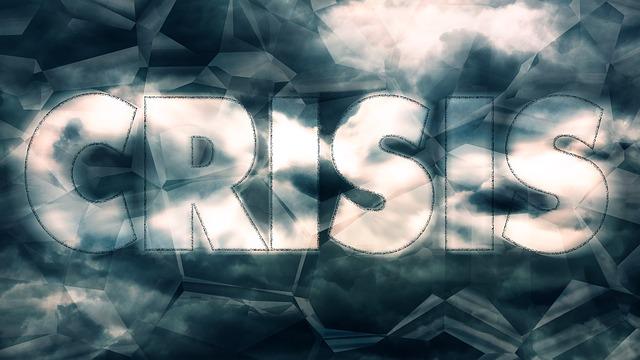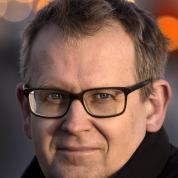Introduction
This article describes the role that media coverage plays in creating awareness of the psychosocial support available to people in Sweden who are affected by crises, accidents, and trauma. The connection between media coverage, psychosocial support and traffic accidents has not been made clear in the literature or previous research. Trauma and fatal injuries in road accidents in Sweden has decreased in recent decades. Developments in China and the European countries shows that many people are killed on the roads and the resulting trauma would be significant for relatives and families who are affected. Therefore, it is important that those affected can get the support needed and requested. The importance of insurance and insurance companies in China has been desribed by Dellien (Dellien, 2011). In Sweden the municipal authorities operate POSOM-groups that provide psychological and social care in the event of major community crisis. However, knowledge and awareness of social support for trauma victims is also very important for insurance companies in Sweden. The economic and social costs of long-term consequences is very important to prevent in society. A Swedish study show that a system called “pay-as-you-speed” (PAYS) could save lives and create at safer road transport system (Stigson et al, 2014). This article describes how team leaders in the POSOM-groups experience accessibility, communication and interactions with the media. The article focuses on how to increase awareness of emergency crisis support for one of today's major public health problems - traffic accidents in the community.
In China, there is a growing demand for knowledge and skills in providing psychosocial support in the context of crisis and trauma (Cuiling, 2010). Traffic injuries in China has been highlighted in several studies in recent years (Wu and Cheung, 2006; Hu et al., 2008; Wu et al., 2008; Zhao, 2009, Alcorn, 2011; Yuan et al., 2012). Both China and Sweden have a great deal of experience and knowledge about treatment for victims of major disasters and accidents (Kulling, 1994; Hagström, 1995; Kulling and Riddez, 2001; Broberg et al., 2005; Lundin and Jansson, 2007; Berg Johannesson et al., 2009; Arnberg et al., 2012). In China several studies have provided insights on major disasters such as earthquakes and their consequences for the inhabitants (Cuiling, 2010; Fan et al., 2011; Ma et al., 2011; Ya-Hong et al., 2012).
The consequences of traffic accidents can create to significant social and economic burdens in China and Europe (Berg et al., 2005; Tierens et al., 2012). In light of the long-term social, psychological and economic consequences of crises, trauma, and accidents in the community, there are several good reasons to try to reduce the damage and costs for individuals, insurance company and society.
China is one of the countries most affected by fatal and serious injuries as a result of road accidents. In Europe more than 1.3 million traffic accidents occur annually, resulting in approximately 43,000 deaths 1.7 million people receiving injuries (European Commission, 2013). In China, 200,619,351 people were killed in traffic accidents during the period 2000–2005 while 2,972,229 people were injured. In the same period, 3183 people were killed in traffic accidents in Sweden, while 150,000 people were injured in traffic accidents. During the period 2000–2010, 1,434,194 people were killed in road traffic accidents in China and Europe. The death rates has declined in recent years but still remains at a high level. In Sweden, the death rate of is the same as it was in 1940 (Central Statistical Office, 2011). In Table 1 a total of 17 randomly selected accidents and disasters in both countries are presented. In these accidents and disasters a total of 3761 people have been killed and 996 injured.
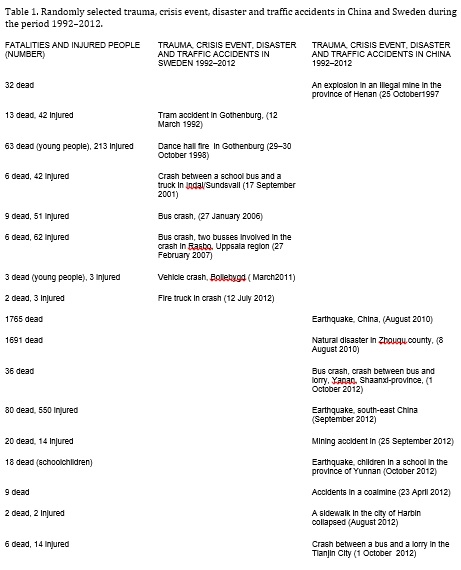
In Sweden nearly all the 290 municipalities have a POSOM-groups. The members include social workers, nurses, priests, deacons, police officers, rescue workers, and teachers.
Aim and Method
The aim of the study was to analyze the team leaders’ experiences of meetings and interaction with the media before and after a crisis event. The study sought to discover what phenomena could be identified and the extent to which the leaders of the POSOM-groups participate in the media coverage and communicate the opportunities for receiving crisis support. The four specific research questions were: 1. To what extent are crisis leaders available in relation to the media? 2. To what extent do the social workers experience good media reporting? 3. How can the POSOM-group become better known to victims and the public? 4. What risks is it possible to identify when a POSOM-group become more accessible to the media? A questionnaire was sent out to the team leaders in POSOM-groups. A total of 223 of 290 POSOM-group leaders responded to the survey. The questionnaire consisted of 14 questions. The informants therefore had the opportunity to write about their experiences of providing crisis support work in the municipalities. The study followed the research ethical principles of the Swedish Research Council.
Research
Previous research in the field of emergency crisis support and psychosocial care in crises, emergencies and disasters in the community have focused on real events, for many years (Arnberg et al., 2011; Arnberg et al., 2012). Studies of disasters and major accidents have been of great importance for the development of crisis support; studies were done, for example, of a hotel fire in Borås in 10 June 1978 (Lorin, 1979; Lundin and Jansson, 2007). From a Scandinavian perspective, acute crisis support improved greatly because of lessons learned in connection with several disasters (Kulling, 1994). Studies have been done on providing crisis aid in the context of natural disasters (Örtenwall et al., 2000; Kulling and Riddez, 2001; Nieminen Kristofferson, 2001; Nieminen Kristofferson, 2002; Broberg et al., 2005; Bergh Johannesson et al., 2009; Hanbert et al., 2011; Brake, 2012).
Results
The team leaders of POSOM-groups expressed satisfaction with their media education. However, 50 percent of the respondents did not have any practical experiences of meeting and interacting with the media. Since media coverage could prevent negative effects and reduce stress for victims and POSOM-group members, the relationship between POSOM-groups and media are important. Of the respondents, 53.4 percent had more than six years of working in the POSOM-group (N=119). The results showed that 40 percent of the POSOM-groups had between 2–5 assignments annually (N=90). Half of the respondents reported they were satisfied with the media coverage of to the work of POSOM-groups (N=103).
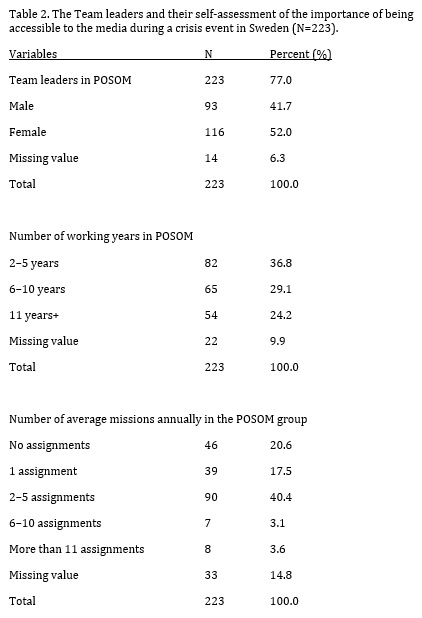
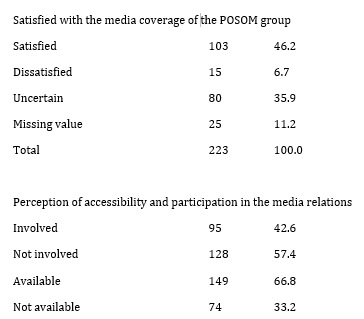
The team leaders of POSOM-groups said several factors were relevant to whether the relationship between a POSOM-group and the media is good. The respondents’ stories have been categorized into five main themes. The first theme can be described as the importance of harmonious relations between the media and the POSOM-group. It is important that both the crisis support workers and reporters have a good understanding of each other's professional roles, because the POSOM-group includes members with different professional backgrounds such as social work, health care, education, emergency services, policing, and churches. A second theme concerned the importance of balance and objectivity in the news coverage of a crisis event, of the psychosocial care and of the POSOM-group and its function and role. A team leaders said: “Balanced and objective media coverage increases people's knowledge of what has happened, what is being done, the understanding of the correctness of the efforts made. This reduces both fantasies and anxieties". The third prominent theme relates to the degree of positive and neutral media coverage of the crisis event. Several informants had told the reporters in a positive way how they could avoid conveying rumors and prevent rumors of a crisis event spreading. A fourth theme relates to the team leaders' experiences of media coverage of providing emergency psychosocial support. One informant said:
When a young man who was a member of the military lost their lives, the POSOM- group was in the church opened in the evenings. On the second day, the magazine had a story about crises, how to react, etc. The coverage described the importance of the POSOM-group and what POSOM did in this case.
When reporting an emergency incident or accident, it is important that the team leader knows what information may be disclosed. Finally, the fifth and final theme relates to the content of good dialogue between the POSOM-group and the media.
The respondents had both positive and negative experiences of the media reporting about psychosocial support. One informant said the following about their positive experiences: "My thoughts are that the media relations and media coverage is an accurate, informative, and factual account of the importance and content of POSOM-group services at various events. Little more is written than that we are active. In this way we also gain credibility with the public".
Discussion
The POSOM-groups can be activated by several different kinds of trauma, crisis incidents, accidents and disasters in the community. A type of crisis events are relatively common are traffic accidents. Although several thousand people died in traffic accidents in Sweden during the last ten years in Sweden, POSOM-groups activated only in a minority of cases. Strangely, in some municipalities POSOM-groups that provide people with emergency crisis support for trauma in road accidents while other municipalities do not provide such emergency support through their POSOM-groups. This creates disparities between municipalities. Municipalities should be able to provide more acute crisis support in connection with this type of crisis. This study has shown that the team leaders of POSOM-groups have a limited practical experience in meeting the media during a crisis event. The study also shows that many team leaders believe that more education and practical media training is needed to bring important messages to the public. For future training of team leaders and members of a crisis team, it may be worthwhile to start by discussing different topics on the theme of risk. One simple proposed means of increasing risk awareness and mental preparedness for the duties of a team leader and a member of POSOM-groups is to provide a reminder consisting of the following 8 questions: a). What could happen? b). What is the worst that could happen? c). How likely is it? d). What would you do then? e). Can you prevent it from happening? f). Can it be made less serious? g). Can it be made less likely? h). Can you handle the situation if it does occur?
References
Alcorn, T., 2011. Uncertainty clouds China’s road-traffic fatality data. World Report. The Lancet, 378 (9788), 305-306.
Arnberg, F., K., Rydelius, P-A., Lundin, T., 2011. A longitudinal follow-up of posttraumatic stress: from 9 months to 20 years after a major road traffic accident. Child & Adolescent Psychiatry & Mental Health, 5 (8), 1-8.
Arnberg, F., K., Eriksson, N-G., Hultman, C., M., Lundin, T., 2011. Traumatic Bereavement, Acute Dissociation and Posttraumatic Stress: 14 Years After the MS Estonia Disaster. Journal of Traumatic Stress, 24 (2), 183-190.
Arnberg, F., K., Hultman, C., M., Michel, P-O., Lundin, T., 2012. Social Support Moderates Posttraumatic Stress and General Distress After Disaster. Journal of Traumatic Stress 25 (6) 721-727.
Berg, J., Tagliaferri, F., Servadei, F., 2005. Cost of trauma in Europe. European Journal of Neurology 12 (Suppl. 1), 85-90.
Bergh Johannesson, K., Lundin, T., Hultman, C., M., Lindam, A., Dyster-Aas, J., Arnberg, F., Michel, P-O., 2009. The Effect of Traumatic Bereavement on Tsunami-Exposed Survivors. Journal of Traumatic Stress, 22 (6), 497-504.
Broberg, A., G., Dyregrov, A., Lilled, L., 2005. The Gothenburg discothèque fire: posttraumatic stress and school adjustments reported by primary victims 18 months later. Journal of Child Psychol Psychiatry, 46 (12), 1279-1286.
Broms, C., 2012. The tsunami – 26 December 2004 – experiences from one place of recovery, Stockholm, Sweden. Primary Health Care Research & Development.
Conrah, U., G., 2005. Förbättra krisstödet inom socialtjänsten. En genomgång av socialtjänstens roll och möjligheter. Rapport nr 2005:2. FoU Västernorrland, Kommunförbundet Västernorrland.
Cuiling, G., 2010. Helping the Helpers: A Community-based Psychosocial Support Model in China. November 2, 2010. Web: http://www.unfpa.org/public/home/news/pid/6837
Dellien, A., 2011. Försäkringsbranschen i Kina. Nordisk Försäkringstidskrift, No 1.
Diaz, J., O., P., Murthy, R., S., Lakshminarayana, R., (2006). Advances in disaster mental health and psychological support. New Delhi: VHAI – Voluntary Health Association of India Press.
European Commission., 2013. Health EU. Your gateway to trustworthy information on public health. Website: (http://ec.europa.eu/health-eu/my_environment/road_safety/index_sv.htm).
Fan, F., Zhang, Y., Yang, Y., Mo, L., Liu, X., 2011. Symptoms of Posttraumatic Stress Disorder, Depression, and Anxiety Among Adolescents Following the 2008 Wenchuan Earthquake in China. Journal of Traumatic Stress, 24 (1), 44-53.
Flannery, R.,B., 1990. Social Support and Psychological Trauma: A Methodological Review. Journal of Traumatic Stress, 3 (4), 593-611.
Gauthamadas, U., 2005. Disaster Psychosocial Response. Handbook for Community Counselor Trainers. Chennai, India: Academy for Disaster Management Education Planning & Training.
Hagström, R., 1995. The Acute Psychological Impact on Survivors Following a Train Accident. Journal of Traumatic Stress, 8 (3), 391-402.
Hanbert, A., Lundberg, L-Å., Rönnmark, L., 2011. Som att lägga ett pussel. Uppföljning tio efter Backabranden.
Hobfoll, S,E., 1998. Stress, Culture and Community: The Psychology and Philosophy of Stress. New York: Plenum.
Hu,G., Wen,M., Baker,TD., Baker,SP. 2008. Road-traffic deaths in China, 1985-2005: threat and opportunity. Injury Prevention, 14 (3), 149-153.
International Federation of Red Cross and Red Crescent Societies. 2003. Community-based psychological support. A training manual. 1st edition – January 2003. Geneva: International Federation of Red Cross and Red Crescent Societies.
International Transport Forum. 2012. Sharing Road Safety. Developing and International Framework for Crash Modification Functions. Research Report, November. OECD and ITF (International Transport Forum).
Lundin, T., Jansson, L., 2007. Traumatic impact of a fire disaster on survivors – a 25-year follow-up of the 1978 hotel fire in Borås, Sweden. Nordic Journal Psychiatry 61 (6), 479-485.
Lundälv, J., 2012. Akut krisstöd och kommunikation. Gävle: Meyers förlag.
Kulling, P., 1994. The Tram Accident in Gothenburg – March 12, 1992. Stockholm: National Board of Health and Welfare, SoS-rapport 1994:2.
Kulling, P., Riddez, L., 2001. Brandkatastrofen i Göteborg natten 29-30 oktober 1998. KAMEDO-report No. 75. Stockholm: National Board of Health and Welfare.
Ma, X., Liu, X., Hu, X., Qiu, C., Wang, Y., Huang, Y., Wang, Q., Zhang, W., Li, T., 2011. Risk indicators for post-traumatic stress disorder in adolescents exposed to the 5.12 Wenchuan earthquake in China. Psychiatry Research 189 (3), 385-391.
Ministry of Transport, Annual Statistical Reports, 2006-2009, China and Traffic Analysis, Stockholm).
Ministry of Public Security Traffic Management Bureau. 2011. Statistical Yearbook on Road Traffic Accidents in P.R.C 2010. Ministry of Public Security Traffic Management Bureau.
Nieminen Kristoffersson,T., 2001. ”På natten ringdes jag in”. Att lära sig av det oförutsebara i krisgruppernas arbete efter branden på Backaplan oktober 1998. Göteborg: FoU i Väst.
Nieminen Kristoffersson, T., 2002. Krisgrupper och spontant krisstöd. Om insatser efter branden i Göteborg 1998. Akademisk avhandling. Lund: Lunds universitet.
Sebag-Montefiore, C., 2012. Minst sex dör i Kinas gruvor – varje dag. – ”Arbetarna är utsatta för övergrepp.” ETC. 11 maj.
Stigson, H, Hagberg, J, Kullgren, A, Krafft, M. (2014). A one year pay-as-you-speed trial with economic incentives for not speeding. Traffic Inj Prev 15(6):612-618.
Tierens, M., Bal, S., Crombez, G., Loeys, T., Antrop, I., Deboutte, D., 2012. Differences in Posttraumatic Stress Reactions Between Witnesses and Direct Victims of Motor Vehicle Accidents. Journal of Traumatic Stress, 25 (3), 280-287.
Wu, X, Hu, J, Zhuo, L, Fu, C, Hui, G, Wang, Y, Yang, W, Teng, L, Lu, S., Xu, G., 2008. Epidemiology of traumatic brain injury in eastern China, 2004: a prospetice large case study. Journal of Trauma 64 (5), 1313-1319.
Ya-Hong-Li,. Zhi-Peng, Xu.. 2012. Psychological crisis intervention for the family members of patients in a vegetative state. Clinics 67 (4), 341-345.
Yuan, Q., Liu, H., Wu, X., Sun, Y., Yao, H., Zhou, L., Hu, J., 2012. Characteristics of acute treatment costs of traumatic brain injury in Eastern China – a multi-centre prospective observational study. Injury. International journal of the care of the injured. 43 (12), 2094-2099.
Zhao, S., 2009. Road traffic accidents in China. CHN, Paper, September 3, 2009.
Wessells, M.G., 1999. Culture, power and community: intercultural approaches to psychosocial assistance and healing. In K Nader, N Dubrow & B Stamm (eds) Honouring Differences: Cultural Issues in the treatment of trauma and loss. New York: Taylor and Francis.
World Bank., 2008. China Road Traffic Safety. The Achievements, the Challenges, and the Way Ahead. Working Paper. China and Mongolia Sustainable Development Unit (EASCS) East Asia and Pacific Region.
World Health Organization. ,2004. World Report on Road Traffic Injury Prevention. Geneva: World Health Organization.
Wu, K,K., Cheung, M.W.L., 2006. Posttraumatic Stress After a Motor Vehicle Accident: A Six-Month Follow-Up Study Utilizing Latent Growth Modeling. Journal of Traumatic Stress, 19 (6), 923-936.
Örtenwall, P., Sager-Lund, C., Nyström, J., Martinell, S., 2000. Katastrofmedicinska lärdomar kan dras av Göteborgsbranden. Läkartid
